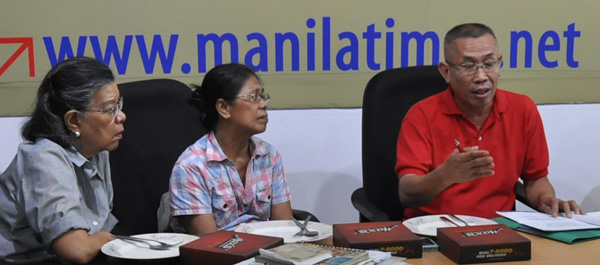A citizens’ coalition on Friday made a fresh call on the government and private businesses to stop what it described as rampant and unjustifiable reclamation efforts at Manila Bay.
Joan Orendain, a proponent of Save Our Shores (SOS) Manila Bay Coalition, said the government should stop all planned reclamation projects because they pose hazards to the public.
Orendain made the call after the city government of Manila stood firm in its plan to reclaim nearly 300 hectares of Manila Bay along Roxas Boulevard.
Her group has also been fighting a joint undertaking by the city of Manila and Manila Goldcoast Development Corp. (MGDC) to reclaim a central portion of the bay.
The City Council of Manila has chosen Goldcoast to be the contractor of the Manila Bay reclamation project, which entails creation of three islands totaling 148 hectares in the bay.
Orendain said the project was approved by the city government even without a “genuine consultation with the people.”
Acting on a 2013 letter from the Ecclesiastical Province of Manila led by Luis Antonio Cardinal Tagle, President Benigno Aquino 3rd transferred the authority to approve reclamation activities from the Philippine Reclamation Authority (PRA) to the National Economic and Development Authority (NEDA).
In evaluating the Manila Goldcoast project, Arsenio Balisacan, NEDA chief, said “this was awarded to Manila Gold Coast Development Corp. (MGDC) in 1991 and is only awaiting clearance from the Office of the President-Office of the Executive Secretary (OP-OES), issuance of the Environmental Compliance Certificate (ECC) from the Department of Environment and Natural Resources (DENR) and the issuance of Notice to Proceed (NTP) by the PRA.”
In his memorandum for the President, Balisacan wrote that Aquino’s Executive Order 146 required reclamation projects to secure NEDA approval and an ECC from the DENR and said the Manila Gold Coast project “is deemed not to require NEDA Board approval since it has been processed by the PRA prior to the effectivity of EO No. 46.”
President Aquino heads the NEDA Board.
Goldcoast has claimed that “the project site is not located in protected or proclaimed areas/sites . . . and will not involve portions of the bay between the Manila Yacht Club and the US Embassy” on Roxas Boulevard.
It said it will put in place pollution abatement facilities and measures against disasters such as a breakwater and a wave deflector for storm surges.
The move by Manila under Mayor Joseph Estrada was contrary to the city’s ordinance passed in 1993 that bans reclamation of that part of Manila Bay.
In June 2011, the Manila City Council passed another ordinance repealing the ban, paving the way for a contract between the city and Goldcoast in April last year.
Orendain said their group wants the contract to be scrapped as it violates Republic Act 7586, which recognizes the value of having a national park in the Manila Bay area.
“The fact is that the area of Roxas Boulevard and Manila Bay are national landmarks. Even the National Historical Commission of the Philippines has declared it so,” Orendain told The Manila Times.
The group instead suggested the enactment of a master plan that maximizes the opportunities and potential of the waterfront for the enjoyment of the people.
In justifying its opposition to the reclamation project, the group cited a scientific study of renowned geologist Kelvin Rodolfo, a professor emeritus at the Department of Earth and Environmental Sciences, University of Illinois at Chicago.
In his study, Rodolfo cited three reasons “why reclamation of nearshore Manila Bay is a very bad idea”—land subsidence or sinking; enhanced effects of storm surges and storm waves caused by typhoons; and liquefaction.
“Even without reclamation, continuing rapid and accelerating subsidence of the coastal lands bordering the bay is worsening both floods and high-tide invasions,” Rodolfo said.
He explained that global warming is raising sea level by about three millimeters per year, which will aggravate Metro Manila flooding.
The second geologic threat to reclaimed areas is the combination of surges and storm waves driven against the country’s coasts by passing typhoons.
“Powerful, but still poorly recognized and understood hazards, storm surges are increasing in strength and frequency as our climate changes,” Rodolfo said.
He added that the greatest hazard that threatens coastal areas is seismically induced liquefaction.
WITH ED TUGADE


